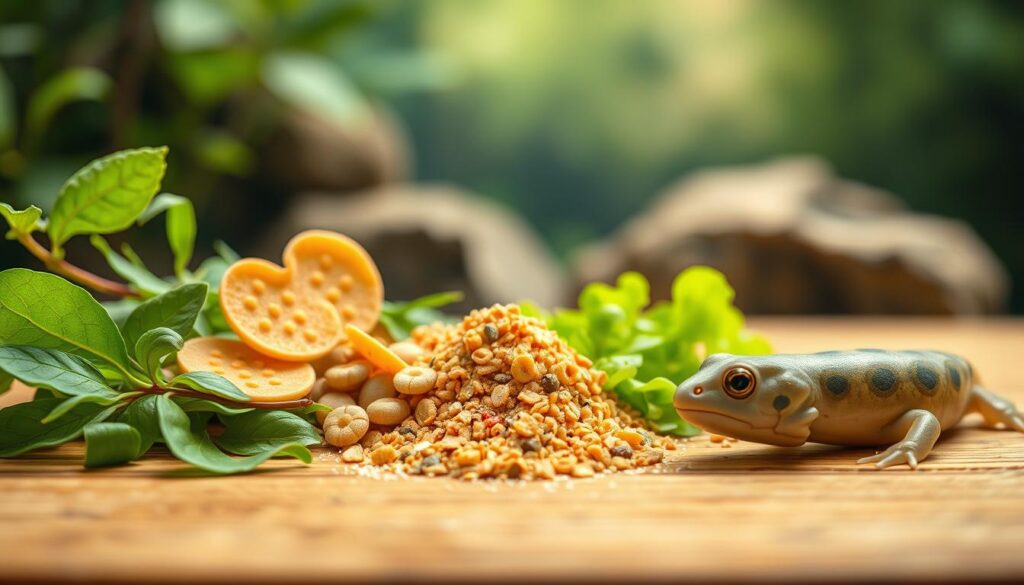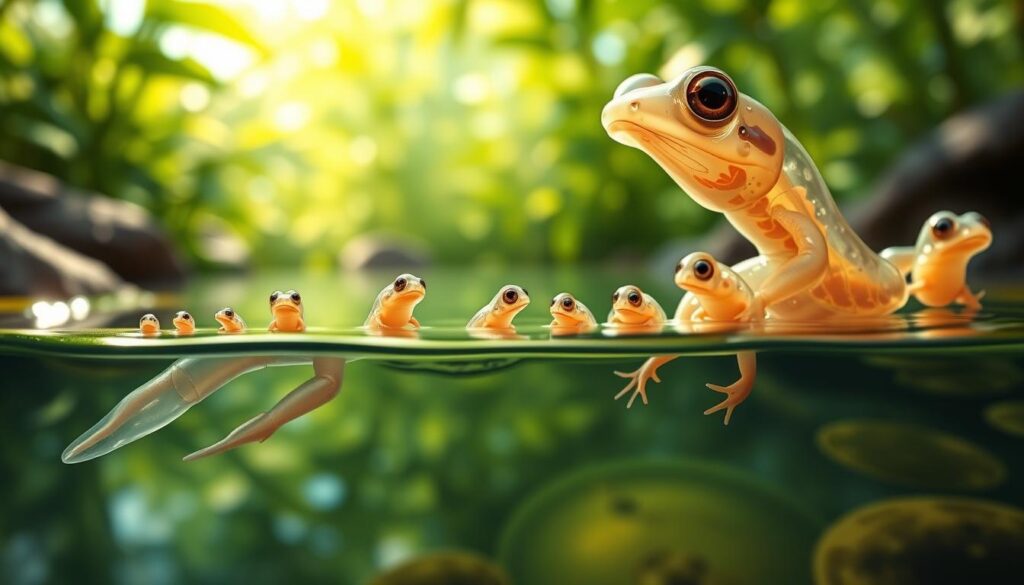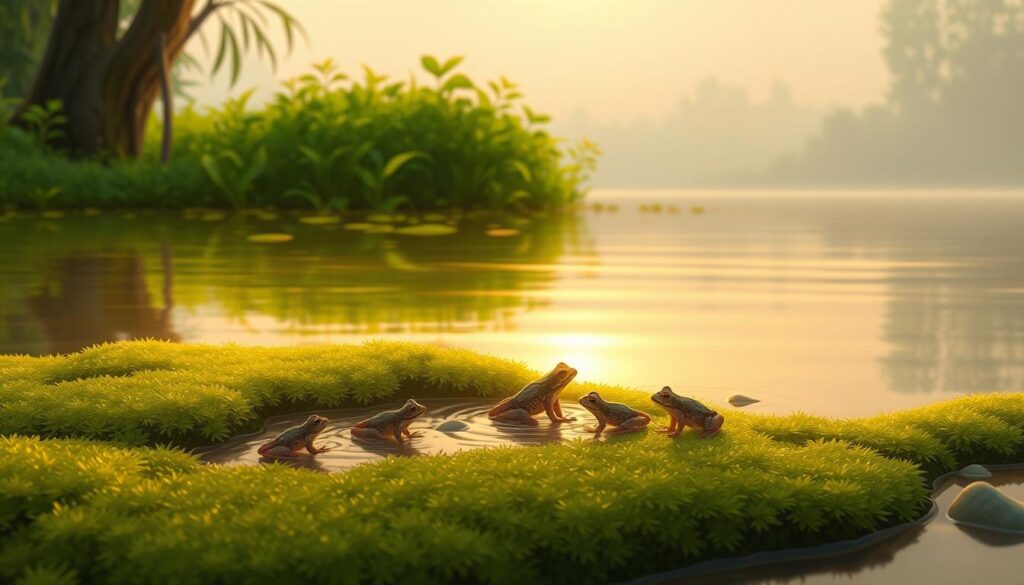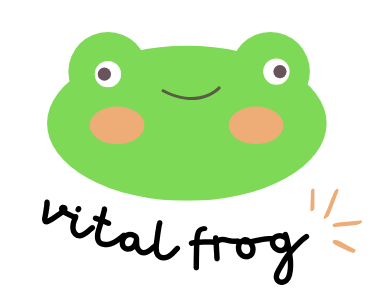Did you know that a single frog can lay up to 4,000 eggs in one season? This incredible number highlights the fascinating journey from egg to froglet, a process that can take as little as 14 to 16 weeks. For families and nature enthusiasts, raising tadpoles at home offers a unique opportunity to witness this transformation firsthand.
This guide focuses on practical care techniques, from setting up the perfect habitat to ensuring ethical release practices. Understanding species-specific needs is crucial, whether you’re raising dart frogs or common pond frogs. With the right setup and attention, this experience can be both educational and rewarding.
Key topics include tank setup, feeding strategies, and troubleshooting common health issues. By following these steps, you can create a safe environment for tadpoles to thrive. For more detailed insights, check out this comprehensive guide on breeding frogs at.
Key Takeaways
- Witness the transformation from egg to froglet in just 14-16 weeks.
- Learn practical care techniques for setting up a tadpole habitat.
- Understand species-specific needs for different types of frogs.
- Ensure ethical release practices once tadpoles mature.
- Explore key topics like tank setup, feeding, and health troubleshooting.
Understanding the Tadpole Life Cycle
The transformation of a tadpole into a frog is one of nature’s most fascinating processes. This journey involves distinct stages, each marked by significant changes in form and function. By understanding these phases, you can better support their growth and ensure a healthy transition.
From Egg to Tadpole: The Early Stages
The life cycle begins with eggs, which vary in appearance depending on the species. For example, dart frog eggs may be white or black and require partial submersion in spring water. In contrast, UK frogspawn typically hatches within two weeks, while toad spawn appears in long strings.
Identifying fertile eggs is crucial. Healthy eggs remain clear or translucent, while moldy ones often turn cloudy or discolored. Optimal hatching conditions include shallow water levels and almond leaf bedding, which mimic their natural environment.
Key Developmental Milestones
Once hatched, tadpoles consume their egg jelly for 3-4 days before transitioning to algae. Their development progresses through three main phases: egg, aquatic tadpole, and terrestrial froglet. Each phase brings unique changes.
At around four weeks, tadpoles absorb their gills and begin developing lungs. By 6-8 weeks, their back legs emerge, followed by the front legs. The tail gradually shrinks as they prepare for life on land. This metamorphosis timeline can vary between species, with dart frogs often developing faster than common pond frogs.
For more insights into species-specific growth, explore this detailed guide on tadpole development.
Setting Up the Perfect Tadpole Habitat
Creating a suitable environment for tadpoles is essential for their healthy development. Whether you’re using a tank or a pond, the setup must mimic their natural habitat. This ensures they grow strong and transition smoothly into froglets.

Choosing the Right Tank or Pond
For communal species, a 10-gallon tank with Fluval Stratum substrate works well. Aggressive species may require filtered setups to prevent overcrowding. Outdoor ponds are ideal for larger groups but need protection from predators.
Water Quality and Temperature
Always use dechlorinated water. Pond or rainwater is best, while untreated tap water can harm tadpoles. Maintain temperatures between 65-72°F for optimal growth. Proper water depth is also crucial—too shallow or deep can stress them.
Adding Plants and Substrate
Live plants like java moss provide oxygen and cultivate biofilm, a natural food source. Floating plants offer shade and hiding spots. For substrate, Fluval Stratum is excellent for planted tanks, while bare-bottom cups suit individual rearing.
Pro Tip: Avoid overcrowding and ensure proper water depth to prevent common mistakes. A well-planned habitat ensures your tadpoles thrive.
Feeding Your Tadpoles: A Balanced Diet
Feeding tadpoles properly is key to their healthy development. Their diet changes as they grow, so understanding what they need at each stage is essential. From algae to insect larvae, providing the right food ensures they thrive and transform into strong froglets.

What Tadpoles Eat at Different Stages
In the first few weeks, tadpoles primarily eat algae and biofilm. As they grow, their diet shifts to include leafy greens like boiled lettuce or spinach. By the fourth week, many species enter a carnivorous phase and require protein-rich food such as insect larvae or fish pellets.
DIY Tadpole Food Recipes
Making your own tadpole food is simple and cost-effective. Try boiling lettuce for 15 minutes, then freezing it with pond water into ice cubes. Another option is spinach puree mixed with calcium-rich eggshell powder. These recipes provide essential nutrients for growth.
Common Feeding Mistakes to Avoid
Overfeeding is a common issue. Uneaten food can rot and harm water quality. Remove leftovers within four hours to prevent this. Also, avoid using untreated tap water, as it may contain harmful chemicals. For more tips, check out this guide on raising frogs from tadpoles.
- Feed algae and biofilm in the first two weeks.
- Introduce leafy greens like spinach by week three.
- Transition to protein-rich foods at four weeks.
- Remove uneaten food promptly to maintain water quality.
Monitoring Tadpole Development
Monitoring tadpole development is a rewarding way to ensure their healthy transformation. By observing their growth, you can identify milestones and address potential issues early. This process helps create a supportive environment for their journey to adulthood.

Recognizing Signs of Healthy Growth
Healthy tadpoles show consistent movement and smooth skin texture. They should actively swim and explore their habitat. If they appear lethargic or have discolored skin, it may indicate a problem.
Handling Common Health Issues
Fungal infections can affect eggs, turning them opaque. To treat this, use antifungal solutions and perform regular water changes. For lethargic tadpoles, ensure clean water and proper feeding schedules.
When to Expect Legs and Froglet Transformation
At 6-8 weeks, back legs begin to emerge. By 8-10 weeks, front legs appear, signaling the final stage of metamorphosis. During this time, the tail absorbs, providing protein for the transformation. Most species complete this process in 10-14 weeks.
- Track growth using charts to monitor body length and limb development.
- Prepare for the terrestrial transition by adding cork bark platforms.
- Watch for “climbing readiness” by tilting cups when legs appear.
By understanding these milestones, you can ensure your tadpoles become strong, healthy froglets. This process is both educational and fulfilling, offering a glimpse into nature’s wonders.
Releasing Your Froglets: A Responsible Approach
Releasing froglets into the wild is a crucial step in their life cycle and requires careful planning. This process ensures they thrive in their natural habitat while protecting local ecosystems. By following ethical guidelines, you can contribute positively to wildlife conservation.

Preparing for Release
Before releasing froglets, acclimate them using native pond water over three days. This helps them adjust to the local environment. Use 20QT tubs with oak leaves and microfauna for pre-release conditioning. These setups mimic their natural habitat and prepare them for life outdoors.
Choosing the Right Environment
Select release sites carefully. Pesticide-free gardens with natural water sources are ideal. Avoid areas with heavy pollution or invasive species. Coordinate releases during warm, humid evenings in spring for optimal survival. This timing ensures froglets have the best chance to adapt.
Ensuring a Smooth Transition
Provide post-release monitoring tips for educators and hobbyists. Watch for signs of adaptation, such as active movement and feeding. Avoid introducing non-native species to local ecosystems, as this can disrupt the balance of nature.
| Release Tip | Details |
|---|---|
| Acclimation | Use native pond water over 3 days |
| Site Selection | Choose pesticide-free gardens with water sources |
| Timing | Release during warm, humid evenings in spring |
| Monitoring | Observe adaptation signs post-release |
By following these steps, you can ensure a responsible and successful release of your froglets. This process not only benefits the wildlife but also fosters a deeper connection with the natural world.
Conclusion
Raising frogs at home is a rewarding experience that teaches valuable lessons about nature. By customizing habitats and providing stage-specific nutrition, enthusiasts can ensure healthy development over weeks or months. Journaling growth milestones with kids using measurement charts adds an educational element to the process.
Eco-conscious practices, like using rainwater and avoiding invasive species, help protect local ecosystems. Complementary activities, such as building log pile habitats for adult frogs, extend the learning journey. For those looking to dive deeper, resources like this guide offer additional insights.
With the right tools and knowledge, this project becomes a meaningful way to connect with nature. Whether for education or enjoyment, raising frogs at home is a fulfilling adventure.
FAQ
What is the best way to set up a habitat for tadpoles?
How often should tadpoles be fed?
How long does it take for tadpoles to develop into froglets?
Can tap water be used for tadpoles?
What are the signs of healthy tadpole development?
When is the right time to release froglets into the wild?
Can tadpoles live with fish?
What should I do if tadpoles stop eating?
How can I involve kids in raising tadpoles?
Are there specific plants that benefit tadpoles?

I’m Lena Adams—a product of an unconventional upbringing in the African wilderness. My father, a daring explorer of African wildlife, sparked my fascination with reptiles, a passion that intertwined with the tragic loss of my mother during an expedition, leaving an indelible mark on my life. Driven to understand the creatures that captivated my parents, I embarked on my journey, sharing insights about reptiles, frogs, and lizards on my website. Through my explorations and conservation efforts, I honour my family’s legacy while seeking connections—to the creatures, nature, and the mother whose presence I yearn to understand.
